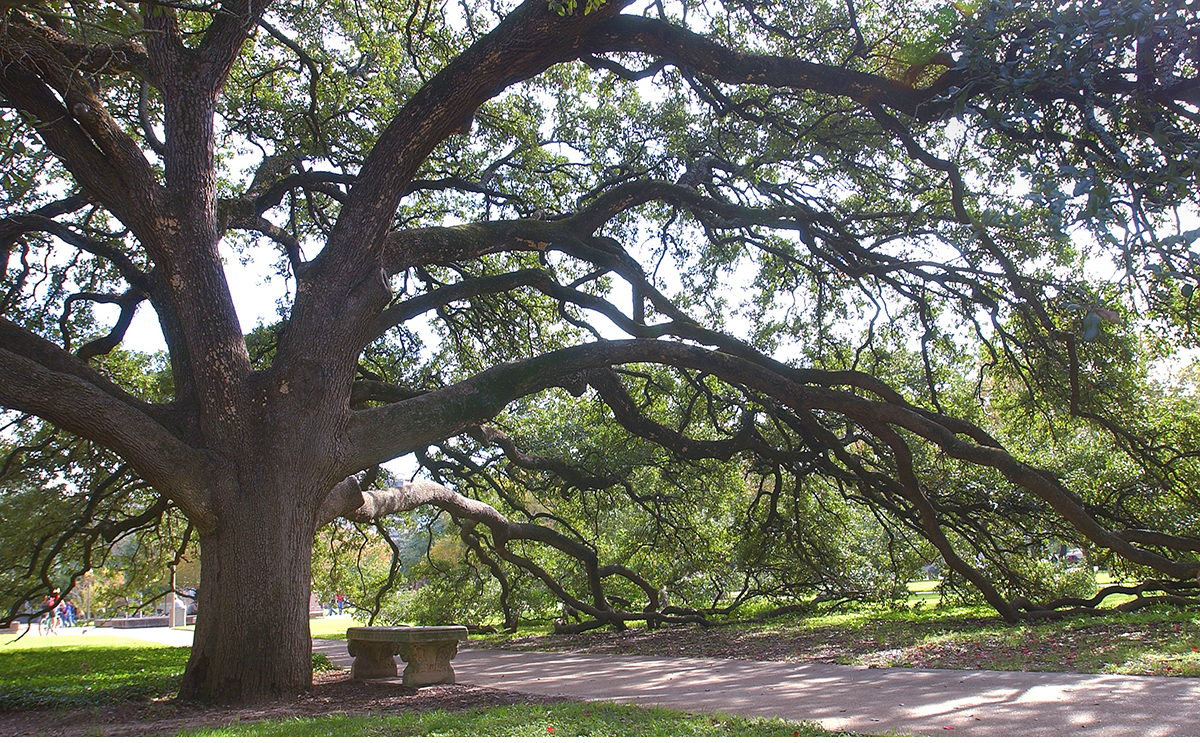Landscape architecture prof highlights trees’ vital role in landscape design

Chip Winslow
Trees are great. The beautiful greenery, the sound of leaves rustling in the wind, and the way they stretch to the sky on a clear blue day seems to brings a sense of peace only Mother Nature can provide. On this Arbor Day, April 26, 2019, William ‘Chip’ Winslow, a landscape architecture professor at Texas A&M University, highlights the vital role of trees in the Earth’s ecosystem.
“The biggest things that trees provide for us are ecosystem services, which helps the entire environment,” Winslow said. “Many people don’t realize that not only do they give off oxygen, essential to our survival, but trees can help absorb water through their root systems.”
Heavy rainfall and flooding can cause devastating damage, but trees can help minimize such damage soaking up the water. As a part of wetlands systems, trees help reduce flooding by decreasing storm water runoff.
“If it’s the right tree in the right place,” said Winslow, “the services that trees bring, such as shade, add value to an area. When you get rid of a tree, you don’t get those anymore, so that value drops.” This is especially true for older trees because they are the most difficult to replace.
Trees can attract tourists and serve in many different capacities, such as providing support for swings and treehouses or sheltering picnic areas, and more.
The aesthetic value that a tree provides can be just as important as its ecosystem services. And while aesthetics certainly aren’t vital to ecosystems, they are simply an added benefit.
Can’t we just “leaf” trees where they are?
Trees are clearly important. Yet it may be difficult to incorporate them into every architectural or landscape design. “Typically, in urban environments, trees are a good thing, but they often get in the way,” Winslow said. “People want their signs and storefronts to be seen and don’t want to deal with fallen leaves and branches, plus there is always ongoing maintenance to be done to keep a tree healthy.”
It can also be tricky to build around a tree or insert one into a certain place. Root systems are vast and can determine whether a tree lives or dies, so workers must be careful when trying to preserve or add a tree. “When preserving a tree, the usual rule of thumb is to stay out of the tree’s drip line,” said Winslow. “You look at the extent of its canopy and draw a line straight down, and anything in that area you leave alone, and the tree has a much better chance of survival during the construction.” To add one, workers must be attentive to give the tree and its roots adequate area to expand and grow, or the root system may be suffocated, eventually killing the tree.
Trees also need to be assessed for health. Some trees are stronger and healthier than others, so when doing construction around one, it is important to determine its likelihood of survival, regardless of the drip line. A design that incorporates a tree into the aesthetic is diminished by the death of the tree. A serious assessment of the tree’s health must take place before any kind of construction can begin.
Because of these considerations, trees are not always planted in dense urban areas. Even without trees, any design can be naturally enhanced. “You can add planters and bring that landscape aesthetic to almost any environment,” Winslow said. “Small shrubs and plants are easy to maintain, and that aesthetic is still attractive to many people.” So, there are many ways to incorporate organic elements into designs.
One last thing to consider when deciding to implement a tree into a design is its history. Many cities have ordinances that forbid removal of trees over a certain size or “heritage” trees.
“These are the kinds of trees that are part of and belong to the community, not just the landowner,” said Winslow. An example of this is Texas A&M’s [Century Tree] (https://tfsweb.tamu.edu/websites/FamousTreesOfTexas/TreeLayout.aspx?pageid=15847) . Not only is it a large, aesthetically pleasing live oak, it also has become a central part of the tradition and culture of the university. “Heritage trees like this one are part of the history of an area and certainly must be planned around,” Winslow said.
Branching out
Including natural elements in landscape provide a multitude of benefits, aesthetic and practical. “Trees are pretty unique, though,” said Winslow. “They’re the one plant that can last for decades and even centuries, so we want to try to keep them.”
By Christina Lynne Davies
Contact:
Richard Nira rnira@arch.tamu.edu
Tags
- archone gallery
- coa gallery
- feature
- land development
- landscape architecture & urban planning
- laup gallery
- rss
- sustainability
Related Posts

Grad LAND students design green West Campus master plan
Design showcases groundwater saving techniques

Students rethink development plans for University Dr.
Follow Us
Facebook Twitter Vimeo Youtube Flickr RSS
Recent Posts

Planning prof heads study of disaster housing aid

A message from the dean

Former student remembered as expert planner

Leading educator named new head of Architecture Dept.






_thumbnail_small.png)
